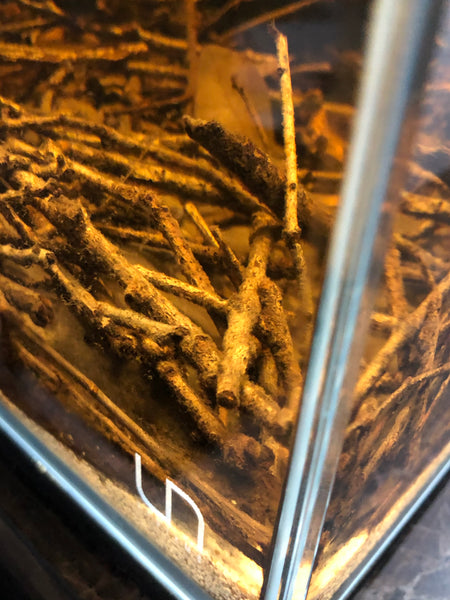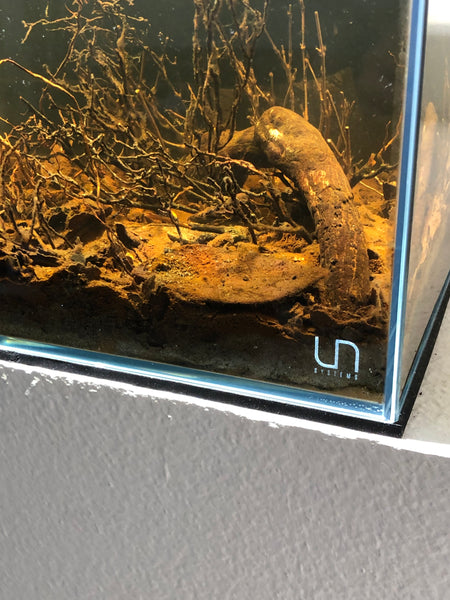- Continue Shopping
- Your Cart is Empty
Contributing to the abundance of the "aquarium biome..."
BIOME: (bi·ome) : A large naturally occurring community of flora and fauna occupying a major habitat.
I'm utterly fascinated by the idea of an aquarium as a habitat, which contains a wide variety of plants and animals. Not only do these life forms constitute a source of ecological balance and environmental stability- they are a source of supplemental food for the resident fishes.
We've talked a lot about allochthonous input- food which comes from outside the aquatic environment- such as insects, fruit, seeds, etc. You know, stuff which literally falls from the trees! However, there is also a significant amount of food which our fishes can obtain which occurs within the aquatic habitat itself.

This is something that we, as lovers of the botanical-style aquarium, are well-suited to embrace. And of course, I"m utterly fascinated by the concept of food production within our botanical-style aquariums! Yes, food production. If you really observe your tank closely- and I'm sure that you do- you'll see your fishes foraging on the botanicals...picking off something.
I've noticed, during times when I've traveled extensively and haven't been around to feed my fishes, that they're not even slightly slimmer upon my return, despite not being fed for days sometimes...
What are they eating in my absence?
Well, there are a number of interesting possibilities.
Perhaps most interesting to us blackwater/botanical-style aquarium people are epiphytes. These are organisms which grow on the surface of wood, botanicals, plants or other substrates, and derive their nutrients from the surrounding environment. They are important in the nutrient cycling and uptake in both nature and the aquarium, adding to the biodiversity, and serving as an important food source for many species of fishes.

In the case of our fave aquatic habitats, like streams, ponds, and inundated forests, epiphytes are abundant, and many fishes will spend large amounts of time foraging the "biocover" on tree trunks, branches, leaves, and other botanical materials.

The biocover consists of stuff like algae, biofilms, and fungi. Although most animals use leaves and tree branches for shelter and not directly as a food item, grazing on this epiphytic growth is which occurs on them is very important.
I am of the opinion that a botanical-style aquarium, complete with its decomposing leaves and seed pods, can serve as a sort of "buffet" for many fishes- even those who's primary food sources are known to be things like insects and worms and such. Detritus and the organisms within it can provide an excellent supplemental food source for our fishes!
It's well known that in many habitats, like inundated forests, etc., fishes will adjust their feeding strategies to utilize the available food sources at different times of the year, such as the "dry season", etc. And it's also known that many fish fry feed actively on bacteria and fungi in these habitats...so I suggest one again that a blackwater/botanical-style aquarium could be an excellent sort of "nursery" for many fish and shrimp species!

You'll often hear the term "periphyton" mentioned in a similar context, and I think that, for our purposes, we can essentially consider it in the same manner as we do "epiphytic matter." Periphyton is essentially a "catch all" term for a mixture of cyanobacteria, algae, various microbes, and of course- detritus, which is found attached or in extremely close proximity to various submerged surfaces. Again, fishes will graze on this stuff constantly.

In the wild habitats, some organisms, such as nematodes and chironomids ("Bloodworms!") will dig into the leaf structures and feed on the tissues themselves, as well as the fungi and bacteria found in and among them. These organisms, in turn, become part of the diet for many fishes.

And the resulting detritus produced by the "processed" and decomposing plant matter is considered by many aquatic ecologists to be an extremely significant food source for many fishes, especially in areas such as Amazonia and Southeast Asia, where the detritus is considered an essential factor in the food webs of these habitats.

And of course, if you observe the behavior of many of your fishes in the aquarium, such as characins, cyprinids, Loricarids, and others, you'll see that, in between feedings, they'll spend an awful lot of time picking at the aforementioned "stuff" on the leaves, stems, and pods within the tank. In a botanical-style aquarium, this is a pretty common occurrence, and I believe it's an extremely important "side benefit" of this type of system!

I believe that a botanical-style aquarium, complete with its decomposing leaves and seed pods, can serve as a sort of "buffet" for many fishes- even those who's primary food sources are known to be things like insects and worms and such. Gut-content analysis of many fishes in the wild confirms this. Detritus and the organisms within the aquarium can provide an excellent supplemental food source for our fishes!

As I've discussed previously, I've maintained several botanical-based aquariums for extended periods of time without supplementary feeding. The fishes were as fat and happy as their brethren in "well fed" aquariums.
In the wild habitats of the world, it's interesting to note that, where materials fall from the trees and surrounding dry areas, the greater the abundance of fishes and other aquatic animals which utilize them is found.
That makes sense.
And materials will continue to fall into the water and accumulate throughout the year, maintaining the richness of the habitat as others decompose or are acted on by the organisms residing in the water- from fungi to fishes!

Not unlike the environment of an aquarium, where we are replacing the botanicals as they break down, right?
Yes! 😆
Again, it's that idea about the "functional aesthetics" of the blackwater, botanical-style aquariums. The idea which acknowledges the fact that the botanicals we use not only look cool, but they provide an important function (supplemental food production) as well.
This is a profoundly important idea.

Perhaps arcane to some- but certainly not insignificant.
And of course, we've talked before about the "botanical nursery" concept- creating an aquarium for fish fry that has a large quantity of decomposing botanicals and leaves to foster the production of these materials, which serve as supplemental food for your fish fry. I have done this before myself and can attest to its viability. You fishes will have a constant supply of "natural" foods to supplement what you are feeding them in the early phases of their life.
Learn to make peace with your detritus! As always, look to the wild aquatic habitats of the world for an example of how this food source functions within the greater biome.

Understand that, when we create a botanical-style aquarium, not only do we have the opportunity to create aquariums which differ significantly from those in years past- we have a unique window into the natural world and the role of these materials in the wild. We're not as freaked out by stuff like detritus and biofilms as we were previously. We're letting go of some of our preconceived notions of what a "healthy" aquarium looks and functions like- and I think that's a HUGE evolution in the hobby.

Consider that the next time you toss some more botanicals into your aquarium! You're not just adding to the "look"- you're contributing to the abundance within the system!
Stay diligent. Stay observant. Stay thoughtful. Stay patient...
And Stay Wet.
Scott Fellman
Tannin Aquatics








Scott Fellman
Author